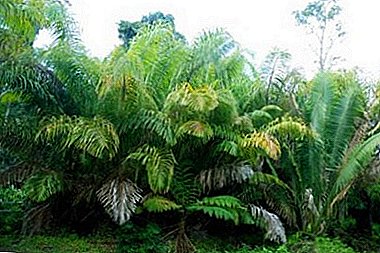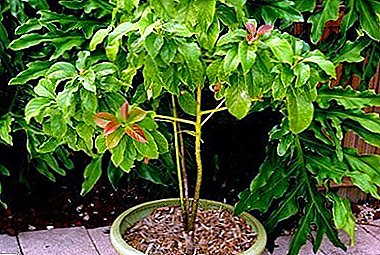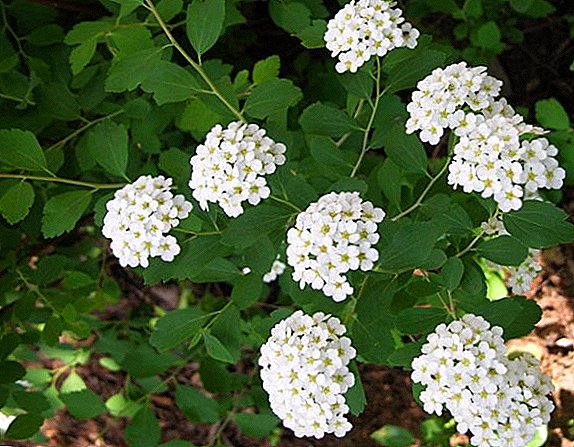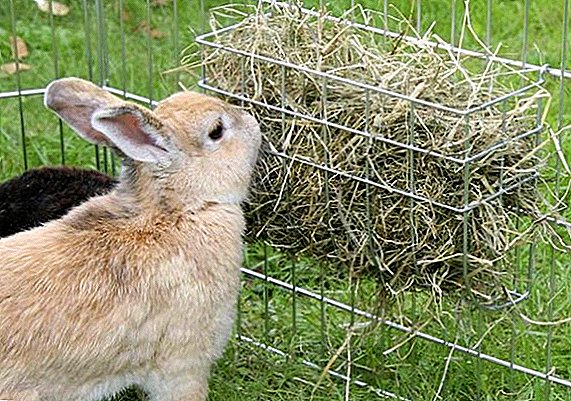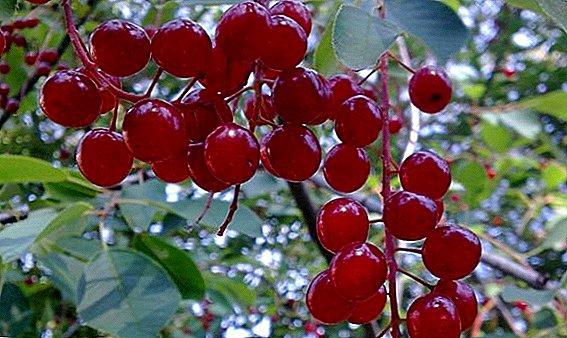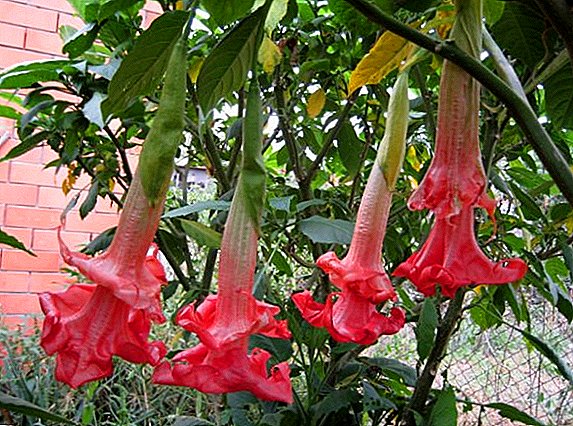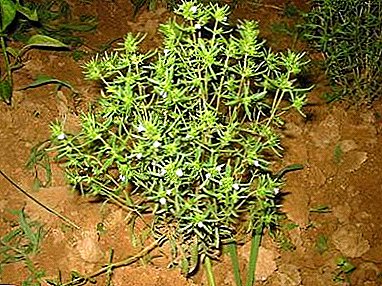
Savory fragrant, garden or vegetable - a source of fresh greens and a storehouse of useful trace elements, essential oils and tannins.
Infusions and decoctions of savory are widely used as an analgesic, bactericidal, antispasmodic and diuretic.
Its addition to vegetable and meat dishes helps speed up the treatment of gastrointestinal diseases, headaches, dizziness, sore throats and colds.
Fresh and dried savory greens are used as a spice in the preparation of a variety of dishes. Consider the garden fragrant savory in more detail, as well as find out whether this plant is perennial or not.
What it is?
Garden savory is a one-year semi-shrub honey spicy culture of the genus Chabber from the family Laminary.
Botanical description
 Cross-pollinated plant. Growth period is 50-55 days and is characterized by a constant increase in foliage. Erect shrub, strongly branched. Flowering long (from July to October).
Cross-pollinated plant. Growth period is 50-55 days and is characterized by a constant increase in foliage. Erect shrub, strongly branched. Flowering long (from July to October).
Seeds are highly germinating and suitable for planting for 6-7 years after harvest. Characterized by self-seeding. Honey culture. In cooking, used as a spicy food additive, as well as a medicinal plant.
Other names:
- condars;
- garden;
- garden;
- Saturea;
- savory fragrant;
- annual savory;
- pepper grass;
- bean grass;
- chob
The Latin name is Satureja hortensis. The English name is Savory.
Taste and smell of this fragrant garden plant
The whole ground part of the plant has a pronounced spicy taste, spicy, overlapping the tastes of other spices and plants. The plant has a strong aroma, reminiscent of thyme and an increase in appetite.
Appearance and photo
Shrub reaches a length of 70-75 centimeters. The root is upright, in the section has a cylindrical shape, thin, up to 18-22 centimeters long. Stems branched, have widely spaced branches, outside covered with curved down short purple fibers, in length reach 30 centimeters.
The foliage is lanceolate-linear, dark green, the leaves are narrow, with sharp edges, reach 1.5-2.5 centimeters in length. Flowers sprout in the leaf axils, upper sessile, lower - on short pedicels, arranged in 3-5 pieces in one sinus and form a loose elongated inflorescence.
Calyx up to 4 centimeters in length, hairy, correct. Corolla: purple or pink in purple speck. The fruit of the plant is represented by a nut of ovoid-triangular shape, dark brown or brown.
You can see in the photo how this plant looks like:




History and geography of habitat
The land of savory are the countries of the East and the Mediterranean. The first records of the plant are found in letters from Ancient Rome, where pepper grass was used to improve memory and attention. Initially savory was distributed among the representatives of the Italian nobility.
In the eighteenth century, plant seeds first came to Europe, where they quickly spread to all countries due to their high survival rate and rapid growth. Currently, the prevailing growth of savory is noted in Southern Europe, Turkey, Crimea, and Central Asia.
Differences from related cultures
- Savory has erect stems that form a shrub, and thyme has a short, spreading plant.
- Tendency to growth and constant growth of foliage.
- The high content of savory tannins and essential oils in the savory distinguishes it from thyme and mint.
- The savory aroma is saturated, balsamic, the thyme is light and sweetish, and the mint tonic.
- Unlike fresh thyme, fresh savory is able to relieve itching after insect bites and reduce swelling.
- The savory root is single, direct, and the thyme has a strongly ramified root system.
- The inflorescences of savory are elongated, the thyme is spherical.
Useful and healing properties
 The healing properties of savory are due to the high content of essential oils in it, among which the most significant are carvacrol, terpenes, cymol.
The healing properties of savory are due to the high content of essential oils in it, among which the most significant are carvacrol, terpenes, cymol.
Essential oils exhibit the following properties:
- Increased appetite.
- Increased secretion of gastric and intestinal juices.
- Mild analgesic effect, muscle spasm relaxation.
- Increased sweating.
- Anthelmintic action.
Tannins, mucus and tar in the composition of savory have strong astringent and diuretic effects, bactericidal and antiseptic properties.
Indications and Contraindications
Indications:
- Erosive gastritis.
- Peptic ulcer.
- Arthritis, chronic pain of the joints and spine.
- Low body weight.
- Acute respiratory infections.
- Intestinal motility dysfunction.
- Angina.
Contraindications:
- Pregnancy.
- Lactation period.
- Hormonal disorders.
- Children age up to 3 years.
- Individual intolerance.
- Fever.
- Kidney disease in the acute stage.
Growing from seed and seedling
 Cultivation conditions: in open field or in greenhouse conditions, at home - in wooden boxes or pots. The plant does not tolerate frosts, thermophilic and light-loving. In the shade it loses aroma and becomes dry.
Cultivation conditions: in open field or in greenhouse conditions, at home - in wooden boxes or pots. The plant does not tolerate frosts, thermophilic and light-loving. In the shade it loses aroma and becomes dry.
- Seed preparation. Certain training activities are required. Seeds are poured with water for 3-5 minutes, after which the surfaced ones are removed. Perhaps pre-soaking in water for 1 day.
- Soil preparation. The soil should be well drained, fertile, loose, moderately wet. Savory also grows well in loamy and sandy soils.
- Sowing seeds. Produced in mid-March or early April. Seeds are sown in the grooves to a depth of no more than 1 centimeter, after which the soil is watered and tamped. Top beds are sprinkled with wood ash, humus or manure. To improve germination using "Agrospan."
Rows are located with 40-50 centimeters between rows. Savory seeds germinate within 3-4 weeks, in the absence of spring rains germination is significantly reduced, which necessitates frequent watering while maintaining a high temperature. For this reason, savory seeds are more often grown by sowing seeds in March in seedlings.
- Planting seedlings. Sprouts 4-5 centimeters long are transplanted to a permanent place in May. Planted seedlings to a depth of no more than 5-7 cm. When the plants reach a length of 10-12 cm, thinning is carried out, leaving them at a distance of 15-20 cm from each other.
Care
- Temperature. The optimum air temperature is 23-28 degrees, humidity - 40-50%.
- The soil. Savory has high requirements for soil fertility. It should be fertilized at least 3 times during the growth period. The soil must be kept wet.
- Shine. Light day should be at least 8 hours. When there is a lack of lighting, dark beds are used to hide the beds or fluorescent lamps.
- Watering. It is carried out at the rate of 10 liters per 1 square meter of soil. Drying and remoistening of the soil is not allowed.
- Top dressing. The first time is carried out at the time of emergence of shoots, the second - when the plants reach a length of 10-12 centimeters, the third - during flowering. As a fertilizer, humus, compost, manure (no more than 1 time), wood ash, tobacco dust, nitroammofosk (15 grams per 10 liters of water), and urea (10-20 grams per square meter) are used.
- Loosening. It is carried out after each watering, if loamy soil is used, and at least 2 times a week when grown in other types of soil. Weeding. It is held at least 1 time per week.
How and when to harvest?
 The leaves of the plant can be collected during the entire period of growth, which will ensure its growth until the first frost. The main part of the crop should be harvested in the early stages of flowering (at the end of July, August), cutting off the stems with a sharp knife so that shoots no more than 10 centimeters remain.
The leaves of the plant can be collected during the entire period of growth, which will ensure its growth until the first frost. The main part of the crop should be harvested in the early stages of flowering (at the end of July, August), cutting off the stems with a sharp knife so that shoots no more than 10 centimeters remain.
Savory is eaten fresh and also dried.
Harvesting technique:
- Spread the grass in a thin layer on newsprint and dry it for a week in a well-ventilated room.
- When the grass dries, the leaves and flower beds are torn off and transferred to glass containers or fabric bags.
- The rest of the plant is hung down by flower beds and they wait for seeds to fall off (within 3-5 days).
Mature seeds are dark brown, almost black in color. After collecting the seeds, they are dried and stored in bags of fabric for 6-7 years.
Diseases and pests
Garden savory is prone to rot and powdery mildew. Diseases contribute to excess irrigation and lack of light.
Manifestations:
- root system decay;
- the appearance of white spots on the leaves;
- drying the plant.
Control measures: compliance with the rules of watering and weeding, treatment of seedlings at the first signs of the disease with Actellic solution or another fungicide.
Benefits for other crops
Savory grows well next to such cultures as:
- solanaceous (tomatoes, peppers, potatoes, eggplants);
- cabbage;
- cucumbers;
- cereals and legumes.
The specific smell of savory helps protect other plants from slugs, Colorado beetles and other pests.
It is not recommended to plant the savory garden next to the thyme.
Savory fragrant - unpretentious in planting and care spice, giving a high yield, which is subject to long-term storage and can be used in food for several years.
The garden savory performs the function of an ornamental and medicinal plant., nice to fit into the garden landscape and being a good neighbor for many food crops. Savory not only gives dishes a memorable taste and aroma, but also increases the appetite, improves memory, immunity and digestive functions.


